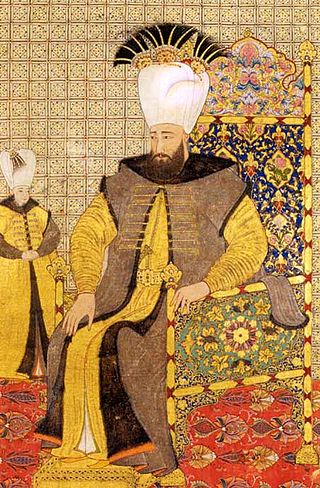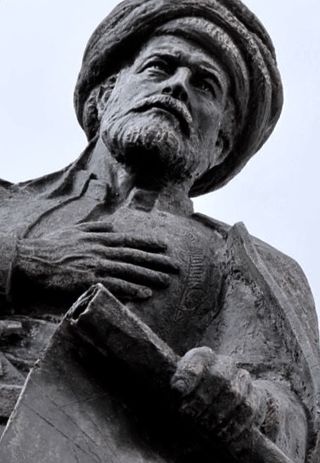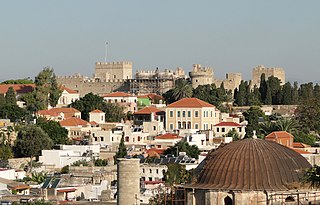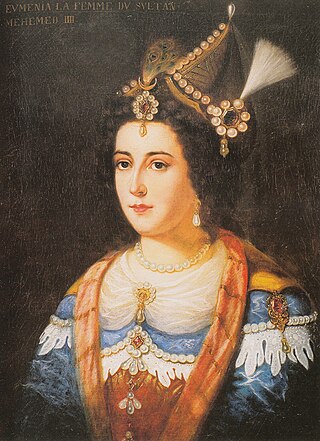Gallery
- The building
- The entrance
- Ceiling
- View from the interior
- Old map of the port of Rhodes from the collection of the library
- General view of the town of Rhodes, 1844
- Grand Master's Palace, 1844
Hafiz Ahmed Agha Library is an important historic Ottoman building in the medieval city of Rhodes in Greece, a UNESCO World Heritage Site. The library was founded by Hafiz Ahmed Agha in 1793.
Hafiz Ahmed Agha was born in the village of Asgourou (Turkish: Uzgur Köyü), 3 km to the south from the present center of the city of Rhodes, in the middle of the 18th century in a wealthy, established Ottoman family. He was educated in the Imperial Court and later became the Chief Equerry of the Sultan. He retired in 1789, but was reactivated and became a member of the regular delegations travelling to Mecca with the yearly presents of the sultan to the Sharif of Mecca. He died on such a travel some time between 1800-1802.
He founded this library for the literate public of his home town with 1995 manuscripts from the entire scope of Islamic science in 1793. The institution became a center of learning. Hafiz Ahmed Agha paid the librarians also for teaching the Arabic language, which was necessary for the reading of the texts.
Presently there are 1256 manuscripts in the possession of the library. Among the most valuables there is a Koran from 1540, the history of the Turkish siege of the city in 1522, and manuscripts with Persian miniatures. On the walls of there are old maps and engravings of the town.

Ahmed III was sultan of the Ottoman Empire and a son of sultan Mehmed IV. His mother was Gülnuş Sultan, originally named Evmania Voria, who was an ethnic Greek. He was born at Hacıoğlu Pazarcık, in Dobruja. He succeeded to the throne in 1703 on the abdication of his brother Mustafa II (1695–1703). Nevşehirli Damat İbrahim Pasha and the Sultan's daughter, Fatma Sultan directed the government from 1718 to 1730, a period referred to as the Tulip Era.

Murad IV was the sultan of the Ottoman Empire from 1623 to 1640, known both for restoring the authority of the state and for the brutality of his methods. Murad IV was born in Constantinople, the son of Sultan Ahmed I and Kösem Sultan. He was brought to power by a palace conspiracy when he was just 11 years old, and he succeeded his uncle Mustafa I. Until he assumed absolute power on 18 May 1632, the empire was ruled by his mother, Kösem Sultan, as nāʾib-i salṭanat (regent). His reign is most notable for the Ottoman–Safavid War, of which the outcome would partition the Caucasus between the two Imperial powers for around two centuries, while it also roughly laid the foundation for the current Turkey–Iran–Iraq borders.

Ahmed Muhiddin Piri, better known as Piri Reis, was an Ottoman navigator, geographer and cartographer. He is primarily known today for his maps and charts collected in his Kitab-ı Bahriye, a book that contains detailed information on early navigational techniques as well as relatively accurate charts for their time, describing the important ports and cities of the Mediterranean Sea.

Ibrahim was the sultan of the Ottoman Empire from 1640 until 1648. He was born in Constantinople, the son of sultan Ahmed I by Kösem Sultan, an ethnic Greek originally named Anastasia.

Mahmud I, known as Mahmud the Hunchback, was the sultan of the Ottoman Empire from 1730 to 1754. He took over the throne after the quelling of the Patrona Halil rebellion. His reign was marked by wars in Persia and conflicts in Europe. He delegated government affairs to his viziers and devoted time to writing poetry. Nader Shah's devastating campaign weakened the Mughal Empire and created the opportunity for Mahmud I to initiate war with cooperation from Muhammad Shah. The alliance ended with the latter's death, leading to tensions between the Afsharids and the Ottomans.

The Topkapı Palace, or the Seraglio, is a large museum and library in the east of the Fatih district of Istanbul in Turkey. From the 1460s to the completion of Dolmabahçe Palace in 1856, it served as the administrative center of the Ottoman Empire, and was the main residence of its sultans.

The Blue Mosque in Istanbul, also known by its official name, the Sultan Ahmed Mosque, is an Ottoman-era historical imperial mosque located in Istanbul, Turkey. It was constructed between 1609 and 1617 during the rule of Ahmed I and remains a functioning mosque today. It also attracts a large number of tourists and is one of the most iconic and popular monuments of Ottoman architecture.

Sedefkar Mehmed Agha or Sedefqar Mehmeti of Elbasan is recorded as the Ottoman Albanian architect of the Sultan Ahmed Mosque in Istanbul.

Rhodes is the principal city and a former municipality on the island of Rhodes in the Dodecanese, Greece. Since the 2011 local government reform, it is part of the municipality Rhodes, of which it is the seat and a municipal unit. It has a population of approximately 56,000 inhabitants. Rhodes has been famous since antiquity as the site of Colossus of Rhodes, one of the Seven Wonders of the Ancient World. The citadel of Rhodes, built by the Hospitalliers, is one of the best-preserved medieval towns in Europe. The Medieval city is designated as a UNESCO World Heritage Site.

The New Mosque and later New Valide Sultan Mosque after its partial reconstruction and completion between 1660 and 1665, is an Ottoman imperial mosque located in the Eminönü quarter of Istanbul, Turkey. It is situated on the Golden Horn, at the southern end of the Galata Bridge, and is a notable Istanbul landmark marking the crossing from the old historic core of the city to the Beyoğlu (Pera) district. The mosque is an notable example of the Sultanate of Women period in Ottoman Empire.

Hala Sultan Tekke is a mosque and takya on the west bank of Larnaca Salt Lake, in Larnaca, Cyprus. Umm Haram, known as Hala Sultan in Turkish tradition, was the wife of Ubada bin al-Samit, a companion of the Islamic prophet Muhammad, and foster sister of Muhammad's mother, Amina.

The siege of Rhodes of 1522 was the second and ultimately successful attempt by the Ottoman Empire to expel the Knights of Rhodes from their island stronghold and thereby secure Ottoman control of the Eastern Mediterranean. The first siege in 1480 had been unsuccessful. Despite very strong defenses, the walls were demolished over the course of six months by Turkish artillery and mines.

The Sulaymaniyya Takiyya is a takiyya in Damascus, Syria, located on the right bank of the Barada River. Commissioned by the Ottoman sultan Suleiman the Magnificent, the western building of the complex was built, following the plans of Mimar Sinan, between 1554 and 1559. Another building was added eastwards from it in 1566 to be used as a madrasa.

Emetullah Rabia Gülnuş Sultan was the haseki sultan of Ottoman Sultan Mehmed IV and valide sultan to their sons Mustafa II and Ahmed III. In the early 18th century, she became one of the most powerful and influential women in the Ottoman Empire.

The following outline is provided as an overview of and topical guide to the Ottoman Empire:

Ahmed Fethi Pasha, was an Ottoman marshal, ambassador and industrialist, who belonged to the Cretan Muslim community.

The kizlar agha, formally the agha of the House of Felicity, was the head of the eunuchs who guarded the Ottoman Imperial Harem in Constantinople.
Ayşe Sultan was an Ottoman princess, daughter of Sultan Ahmed I and Kösem Sultan, half-sister of Sultan Osman II and sister of Sultan Murad IV and Sultan Ibrahim of the Ottoman Empire. Ayşe is known for her many politically motivated marriages.
Hatice Sultan was an Ottoman princess, the daughter of Sultan Ahmed III and one of his consorts, Rukiye Kadın.

The Mehmet Agha Mosque is a historical Ottoman-era mosque on the Aegean island of Rhodes, Greece. Built in the early nineteenth century, it is not open for worship like most of the other mosques on the island. It stands on a prominent place on Sokratous street in the commercial center of the medieval town of Rhodes.